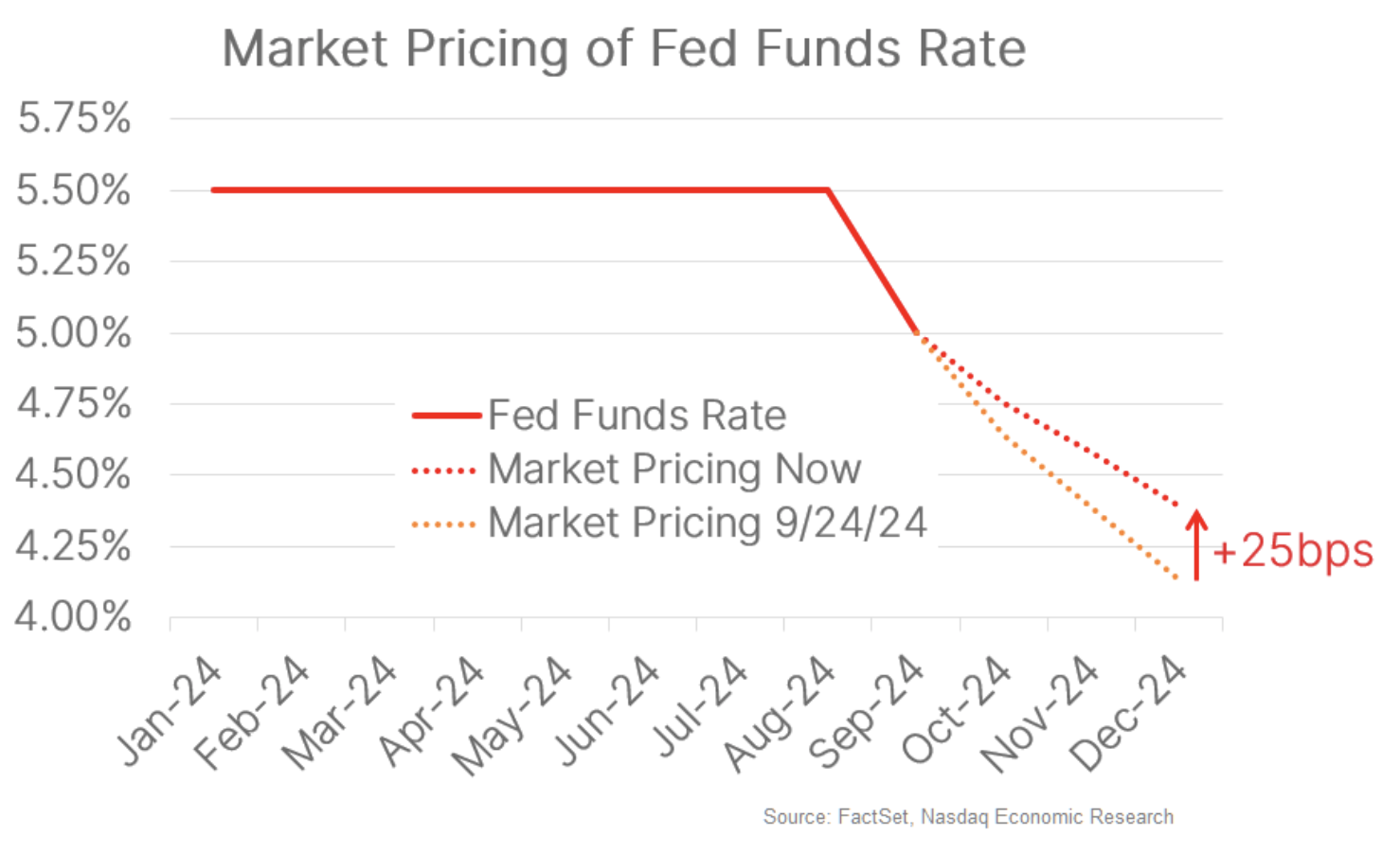
String of strong data has markets reduce rate cut expectations this year by 25bps
The US economy has seen a string of good data recently and it has markets dialing back their (aggressive) rate cut pricing.
10 days ago, markets were pricing 80bps in cuts this year (chart below, orange dotted line). Now it’s 55bps (red dotted line), pretty much in line with the Fed’s plan for 50bps in cuts.

So what’s changed?
Unemployment rate falls to 4.1% and +254k jobs added in September
Top of the list is today’s jobs report, which beat expectations on every dimension:
- The unemployment rate fell to 4.1% against expectations of no change from 4.2%
- The economy added +254k jobs – over 100k above expectations (chart below)
- The previous two (weak) months were revised up by +72k jobs total
- Wage growth rose +0.4% m/m, edging out expectations for a +0.3% increase

Of course, one month doesn’t make a trend, but it helps ease concerns about further deterioration in the labor market.
Services sector is picking up, even as Manufacturing fades
Yesterday’s survey of Services business activity showed that sector remains the engine of the economy.
The ISM Services PMI rose to 54.9 (chart below, green line) – comfortably in expansion (50+) and a 17-month high. Plus, this strength was corroborated by the S&P Services PMI, which sits at 55.2.

On the downside, the Manufacturing revival we saw early this year has faded (red line). But Manufacturing is a small part of the economy (~10% of GDP) compared to Services (~75%).
Given its much larger size, Services can keep the overall economy expanding, even if Manufacturing is contracting (that’s what we saw in 2023).
Revisions show consumer spending growing at sustainable pace as incomes rise
The other engine of the economy is consumers. And recent revisions helped make sense of their surprising strength.
Two months ago, we highlighted how consumer spending growth was being supported by real income gains. But it was “not sustainable” since spending (+3% YoY, chart below, orange line) was rising faster (red arrow) than income (+1% YoY, light green area).
After revisions, that spending growth looks a lot more sustainable. Now, income (dark green area) and spending are both growing about +3% YoY.

Real GDP in on pace to grow +2.5% in Q3 after averaging +2.3% in H1 2024
With the Service sector picking up (~75% of GDP by industry) and consumer spending growing at a solid pace (~70% of GDP by expenditure), we’re set for another quarter of solid GDP growth.
After growing at a +2.3% pace in the first half of the year, the current estimate for Q3 real GDP growth is +2.5% (chart below, green line) – and that’s before taking today’s jobs report into account.
So the overall economy looks pretty healthy.

Headline PCE inflation is down to 2.2% YoY – just above Fed’s 2% target
Of course, the other area of concern for the Fed is inflation, and that’s giving them the go-ahead to cut rates, too.
Headline PCE inflation has fallen all way to 2.2% YoY in August (chart below, orange line) from a peak of 7.2%. That’s almost all the way back down to the Fed’s 2% inflation target (dashed line).

Recent data supports Fed’s preference for 25bps rate cuts
All told, it looks like the economy is doing well and the labor market is holding up. At the same time, inflation is nearly back to target.
This all supports the Fed’s plan to lower rates 25bps at a time. And it seems markets are coming around to that view. Of course, we have one more inflation and jobs report each before the Fed’s next meeting, so that could change.
The information contained above is provided for informational and educational purposes only, and nothing contained herein should be construed as investment advice, either on behalf of a particular security or an overall investment strategy. Neither Nasdaq, Inc. nor any of its affiliates makes any recommendation to buy or sell any security or any representation about the financial condition of any company. Statements regarding Nasdaq-listed companies or Nasdaq proprietary indexes are not guarantees of future performance. Actual results may differ materially from those expressed or implied. Past performance is not indicative of future results. Investors should undertake their own due diligence and carefully evaluate companies before investing. ADVICE FROM A SECURITIES PROFESSIONAL IS STRONGLY ADVISED. © 2024. Nasdaq, Inc. All Rights Reserved.
